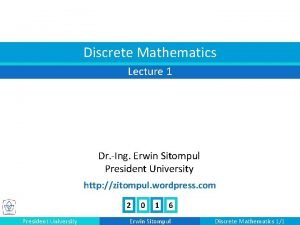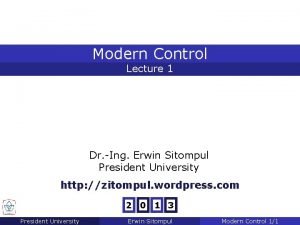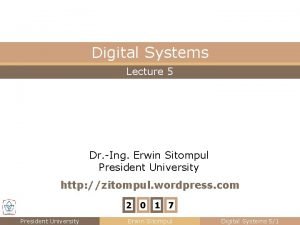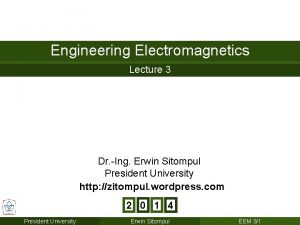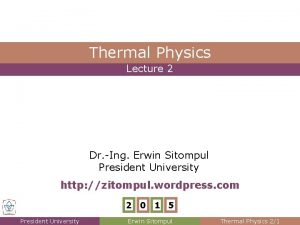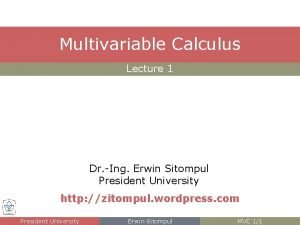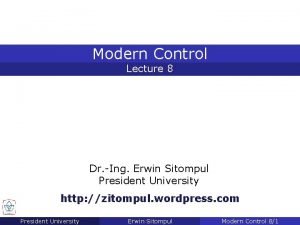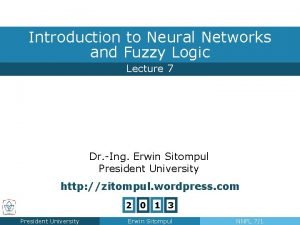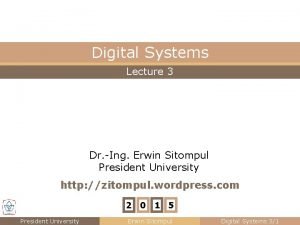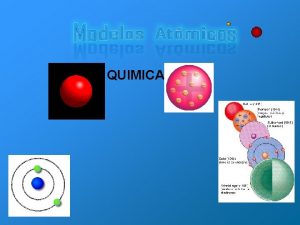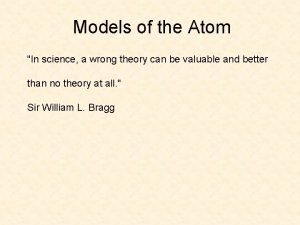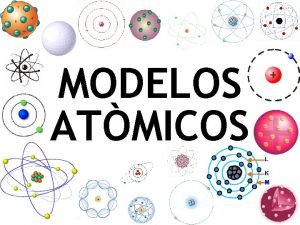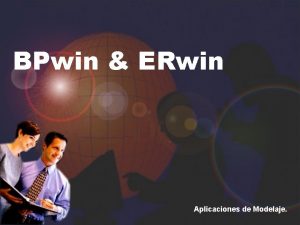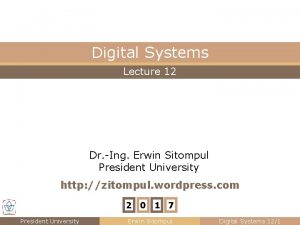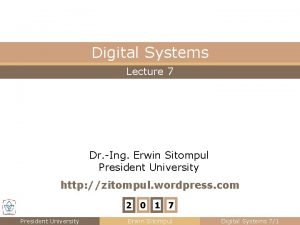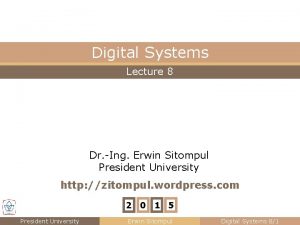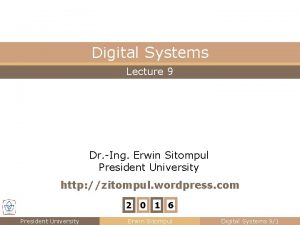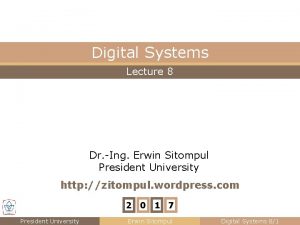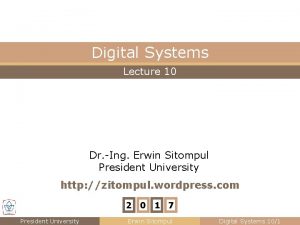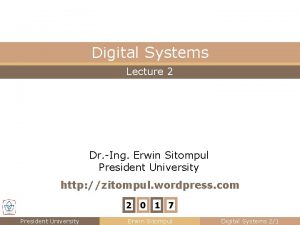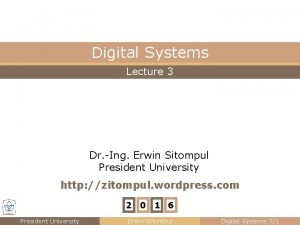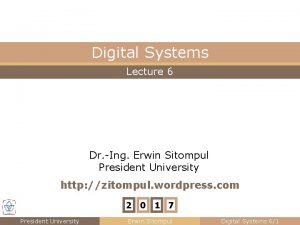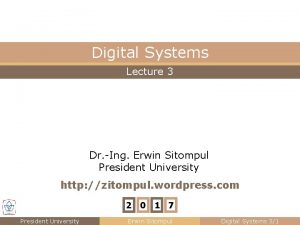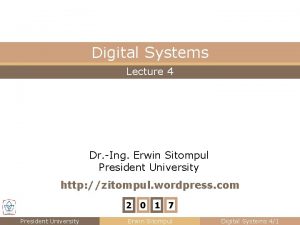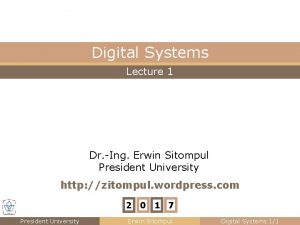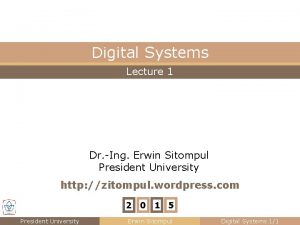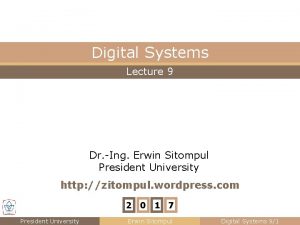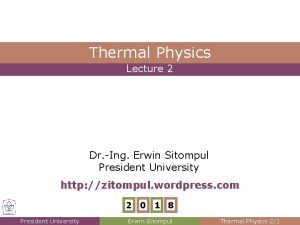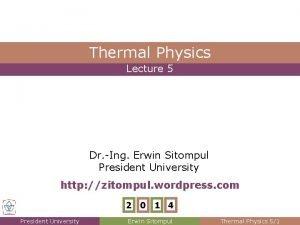Digital Systems Lecture 5 Dr Ing Erwin Sitompul



























- Slides: 27

Digital Systems Lecture 5 Dr. -Ing. Erwin Sitompul President University http: //zitompul. wordpress. com 2 0 1 7 President University Erwin Sitompul Digital Systems 5/1

Digital Systems Section 6 Optimized Implementation of Logic Function President University Erwin Sitompul Digital Systems 5/2

Lecture Digital Systems Circuit Minimization with Karnaugh Maps n It is our intension to simplify a Boolean expression into an optimal and minimum form. n Algebraic manipulations can be used to simplify Boolean expression. We have done this before. This process is not always straightforward and easy. n Karnaugh maps (K-maps) provide an easy and visual method for finding the minimum-cost So. P (or Po. S) for a Boolean expression. n A K-map is a pictorial arrangement of the truth table which allows easy interpretation for choosing the minimum number of terms needed to algebraically express a function. n The minimization using K-map is simple. It is much faster and more time-efficient than the minimization techniques with Boolean Algebra. n K-maps works well for Boolean expressions of up to 6 input variables/ literals. President University Erwin Sitompul Digital Systems 5/3

Lecture Digital Systems Circuit Minimization with Karnaugh Maps n K-map is an approach to minimize Boolean Function. n The representation in the form of sum-of-product can be easily converted from the truth table. n The minimization using K-map is simple. It is much faster and more time-efficient than the minimization techniques with Boolean Algebra. President University Erwin Sitompul Digital Systems 5/4

Lecture Digital Systems Karnaugh Maps n Karnaugh map is an alternate way of representing Boolean Function. See the graphs below. n All rows of the output column from the truth table is represented with a square in Karnaugh map. 2 -Variable Function ● Truth Table A B F 0 0 m 0 0 1 m 1 1 0 m 2 1 1 m 3 President University ● Karnaugh Map B 0 1 0 m 1 1 m 2 m 3 A Erwin Sitompul Digital Systems 5/5

Lecture Digital Systems Karnaugh Maps 3 -Variable Function • Truth Table A B C F 0 0 0 m 0 0 0 1 m 1 0 m 2 0 1 1 m 3 1 0 0 m 4 1 0 1 m 5 1 1 0 m 6 1 1 1 m 7 President University ● Karnaugh Map BC 00 01 11 10 0 m 1 m 3 m 2 1 m 4 m 5 A Erwin Sitompul m 7 m 6 Digital Systems 5/6

Lecture Digital Systems Karnaugh Maps 4 -Variable Function CD 00 AB 00 m 0 01 11 10 m 1 m 3 m 2 01 m 4 m 5 m 7 m 6 11 m 12 m 13 m 15 m 14 10 m 8 m 9 m 11 m 10 President University Erwin Sitompul Digital Systems 5/7

Lecture Digital Systems Karnaugh Maps n Every row in the output column of a truth table can be written in the form of minterms. n Correspondingly, every square of a Karnaugh map can be written in the form of minterms, too. n So. P can be obtained as the sum of all minterms. ● Karnaugh Map ● Truth Table A B F 0 0 1 1 1 0 0 1 1 0 B B 0 1 1 0 A’B’ A’B 1 0 0 1 AB’ AB A A 0 1 F = m 0 + m 1 = A’B’ + A’B President University Erwin Sitompul Digital Systems 5/8

Lecture Digital Systems Karnaugh Maps n K-map of 3 -variable function: ? A ● By writing SOP, what is F for this 3 -variable K-map? ● F(A, B, C) = Σm(1, 2, 4, 5, 6, 7) ● F = AB’C’ +AB C +ABC + A’B’C + A’BC’ ● F(A, B, C) = πM(0, 3) ● F = (A+B+C)(A+ B’+C’) n K-map of 4 -variable function: ? A ● By writing SOP, what is F for this 4 -variable K-map? ● F(A, B, C, D) = Σm(2, 3, 4, 6, 7, 8, 14, 15) ● F(A, B, C, D) = πM(0, 1, 5, 9, 10, 11, 12, 13) ● F =… President University Erwin Sitompul Digital Systems 5/9

Lecture Digital Systems K-map: Sum-of-Product Minimization n If we take a closer look to a K-map, we can see that any 2 neighboring squares are only differ by a single literal. n For example, m 1 (A’B’C) and m 5 (AB’C) m 3 (A’BC) and m 2 (A’BC’) m 4 (AB’C’) and m 6 (ABC’) n We can simplify the neighboring squares as follows: m 1 + m 5 = A’B’C + AB’C = (A’ + A)B’C = B’C m 3 + m 7 = A’BC + ABC = (A’ + A)BC = BC BC A 00 01 11 10 0 m 0 m 1 m 3 m 2 1 m 4 m 5 m 7 m 6 n Four neighboring squares are now becomes two rectangles. President University Erwin Sitompul Digital Systems 5/10

Lecture Digital Systems K-map: Sum-of-Product Minimization n Now, the 2 neighboring rectangles can be further simplified as: m 1 + m 5 + m 3 + m 7 = B’C + BC BC = (B’ + B)C A 00 01 11 10 =C 0 m 1 m 3 m 2 1 m 4 m 5 m 7 m 6 n This is the way how we can use K-map to simplify Boolean functions. We try to cover all minters in the biggest possible squares/ rectangles, and simplify each of them. n The Boolean property that we use is: x · y + x · y’ = x (Combining, see Lecture 2) President University Erwin Sitompul Digital Systems 5/11

Lecture Digital Systems K-map: Sum-of-Product Minimization n Practically, any neighboring cells or rectangles will have one or more common literals and exactly one different literal. n They can be grouped in squares or rectangles with the dimension of [2 n × 2 m]. BC n 2 neighboring cells in a 3 -variable function: A 00 01 11 10 AB’C + AB’C’ = AB’(C+C’) 0 m 1 m 3 m 2 = AB’ 1 m 4 m 5 m 7 m 6 n 4 neighboring cells in a 4 -variable function: A’B’CD’ + A’BCD’ + AB’CD’ + ABCD’ = A’(B’+B)CD’ + A(B’+B)CD’ CD AB 00 01 11 10 = (A’+A)(B’+B)CD’ = CD’ 00 m 1 m 3 m 2 01 m 4 m 5 m 7 m 6 11 m 12 m 13 m 15 m 14 10 m 8 m 9 m 11 m 10 President University Erwin Sitompul Digital Systems 5/12

Lecture Digital Systems Rules for Karnaugh Maps n We can simplify a Boolean expression by encircling 1’s in the Karnaugh map by using “power-of-2 rectangle”. n This means, the dimension of the rectangle must be [2 n× 2 n] n The rectangles may contain 1, 2, 4, 8, … cells of 1’s. n Only cells of 1’s may be encircled. n All the 1’s must be enclosed in the smallest possible number of rectangles. n All the 1’s must be encircled with rectangles with the biggest possible size. n Encircling a 1 more than once is allowed. n We can then deduced a minterm for each rectangle. Rectangles with dimension greater than [1× 1] form minimized minterms. President University Erwin Sitompul Digital Systems 5/13

Lecture Digital Systems Rules for Karnaugh Maps n Encircled pair of adjacent 1 s in K-map eliminates one variable that appears in true and complemented form. n Encircled quad of adjacent 1 s eliminates two variables that appear in both true and complemented form. n Encircled octet of adjacent 1 s eliminates three variables that appear in both true and complemented form. n Variables that are the same for all encircled squares must appear in the final expression. President University Erwin Sitompul Digital Systems 5/14

Lecture Digital Systems Some Terminologies n An implicant is a rectangle that encircles 1, 2, 4, 8, … cells of 1’s and may not include any cells of 0’s. n A prime implicant is an implicant that is not fully contained in any one other implicant. n An essential prime implicant is a prime implicant that includes at least one 1 that is not included in any other implicant. ● Implicants President University ● Prime implicants, but not essential Erwin Sitompul Digital Systems 5/15

Lecture Digital Systems Simplification Using K-maps A’ F(A, B) = Σm(0, 1) F = A’ B’C BC’ F(A, B, C) = Σm(1, 2, 4, 5, 6, 7) F = A + B’C + BC’ A President University Erwin Sitompul Digital Systems 5/16

Lecture Digital Systems Exercise: Simplification Using K-maps A’C’ B AB F=B F = A’C’ + AB BC AB AC F = AB + AC + BC President University Erwin Sitompul Digital Systems 5/17

Lecture Digital Systems Exercise: Simplification Using K-Maps B’D’ BC’D A F = C +A’BD + B’D’ ? BC’D’ ● What is the minimized F? ABD’ AC’ F = AC’ + BC’D’ + ABD’ President University Erwin Sitompul Digital Systems 5/18

Lecture Digital Systems Exercise: Simplification Using K-Maps Simplify the following function by using K-map: F(A, B, C, D) = Σm(0, 2, 3, 5, 6, 7, 8, 10, 11, 14, 15). A● F = C + B’D’ + A’BD President University Erwin Sitompul Digital Systems 5/19

Lecture Digital Systems Summary: Karnaugh Maps n Karnaugh map is an alternate approach to represent Boolean expressions. n Karnaugh map representation can be used to minimize Boolean expressions through some easy steps/rules. n Nevertheless, not all functions can be reduced, and still have to be represented in their canonical minterms. n Note: a canonical minterm is a minterm with all possible literal present. n For example, in a 4 -variable function, AB’ can be a minterm, but its canonical minterms are AB’CD, AB’CD’, AB’C’D, and AB’C’D’. President University Erwin Sitompul Digital Systems 5/20

Lecture Digital Systems Don’t Care Conditions n In some situations, we don’t care about the value of a function for certain combinations of the variables. n These combinations may be impossible to occur in a certain contexts or the value of the function may not matter when they occur. n In such situations mentioned above, we say the function is incompletely specified. n There are multiple (completely specified) logic functions that can be used in the design. So, we can utilize the don’t cares to create the simplest possible circuit. n When constructing the rectangles in the simplification procedure, we can choose either to cover or not to cover the don’t cares. n Don’t cares can be treated as 1’s or 0’s, depending on which is more advantageous. n It may be covered or not. It is denoted with X’s. President University Erwin Sitompul Digital Systems 5/21

Lecture Digital Systems Don’t Care Conditions n Here is an example of a Karnaugh map with don’t cares (X). ● Covering 1’s without utilizing X ● Covering 1’s utilizing X n Instead of using 2 -cell implicants, we can use 4 -cell implicants, and the Boolean function can be better simplified. n Instead of F = A’BD’ + BC’D we can use F = BC’ + A’B President University Erwin Sitompul Digital Systems 5/22

Lecture Digital Systems Exercise: Don’t Care Conditions F(A, B, C, D) = πM(0, 2, 3, 9) + d(4, 5, 7, 8, 14) F = B + AC + A’C’D F(A, B, C, D) = Σm(0, 2, 4, 5, 6, 12, 13, 15) + d(1, 7, 8, 11, 14) F = B + A’D’ President University Erwin Sitompul Digital Systems 5/23

Lecture Digital Systems Exercise: Don’t Care Conditions 5 -Variable Function YZ 00 01 11 10 WX 1 1 00 0 01 0 X 1 1 01 0 0 X 1 11 1 1 0 X 11 1 1 X X 10 1 1 0 X 1 X X V=0 V=1 F = WY’ + VY + W’XY President University Erwin Sitompul Digital Systems 5/24

Lecture Digital Systems Exercise: Don’t Care Conditions Simplify the following function by using K-map: F(A, B, C, D) = Σm(1, 3, 5, 7, 9) + d(6, 12, 13). A● F = A’D + B’C’D ● F = A’D + C’D President University Erwin Sitompul (without don’t cares) (with don’t cares) Digital Systems 5/25

Lecture Digital Systems Homework 5 (1/2) 1. Two K-maps are presented below, each for different function. Using So. P minimization, find the minimum realizations and calculate the cost of the circuit. 2. See next slide. CD AB 00 01 11 10 00 0 1 01 0 0 11 1 0 10 1 1 0 1 AB CD 00 01 11 10 President University Erwin Sitompul 00 0 1 1 11 1 0 0 1 1 1 1 Digital Systems 5/26

Lecture Digital Systems Homework 5 (2/2) 2. For the following K-maps, find the minimum YZ realization using So. P minimization, by using WX 00 01 11 10 and not using don’t cares (X). Calculate 1 0 00 0 X the costs. Which one is cheaper? 01 1 0 11 1 X 1 1 10 0 0 1 1 n Please write your Class number after your Student ID. n Deadline: 1 day before class. Monday, 9 October 2017 (Class 2). Tuesday, 10 October 2017 (Class 1). President University Erwin Sitompul Digital Systems 5/27
 Erwin sitompul
Erwin sitompul Erwin sitompul
Erwin sitompul Erwin sitompul
Erwin sitompul Erwin sitompul
Erwin sitompul Erwin sitompul
Erwin sitompul Digital systems
Digital systems Erwin sitompul
Erwin sitompul Erwin sitompul
Erwin sitompul Erwin sitompul
Erwin sitompul Erwin sitompul
Erwin sitompul Erwin sitompul
Erwin sitompul Electric flux density
Electric flux density Erwin sitompul
Erwin sitompul 01:640:244 lecture notes - lecture 15: plat, idah, farad
01:640:244 lecture notes - lecture 15: plat, idah, farad Logic sitompul
Logic sitompul Logic sitompul
Logic sitompul Advanced operating system notes
Advanced operating system notes Lecture sound systems
Lecture sound systems Lecture sound systems
Lecture sound systems Art as a humanistic discipline summary
Art as a humanistic discipline summary Modelo de dalton mg
Modelo de dalton mg Erwin schrödinger atomic theory
Erwin schrödinger atomic theory Cuales son los modelos atomicos
Cuales son los modelos atomicos Schrodinger atomic theory
Schrodinger atomic theory Erwin moeyaert
Erwin moeyaert Bpwin online
Bpwin online Schrodinger atomic theory
Schrodinger atomic theory Erwin vs powerdesigner
Erwin vs powerdesigner



